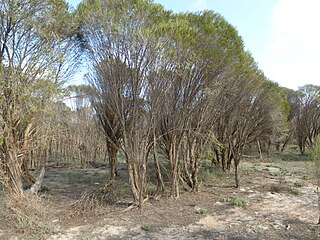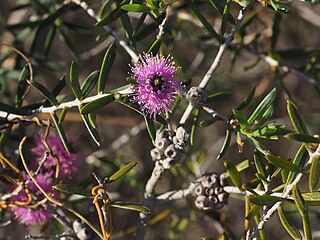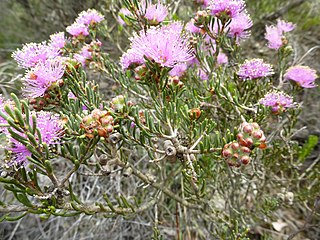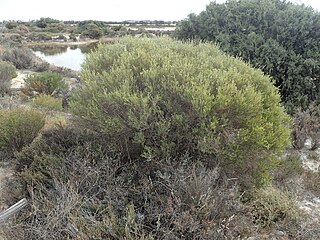
Melaleuca amydra is a plant in the myrtle family, Myrtaceae and is endemic to the south-west of Western Australia. It is similar to Melaleuca ryeae with its small, compact form, oval leaves and "pom-pom" heads of pink to purple flower heads on the ends of the branches in spring.

Melaleuca atroviridis is a plant in the myrtle family, Myrtaceae and is endemic to the south-west of Western Australia. It was formerly included in the species Melaleuca uncinata but a review of that species lead to the identification of a number of new species. Like M. uncinata, this species is used for the production of brushwood fencing. It has fewer stamens in the flowers and somewhat smaller clusters of fruit but has the same needle-like leaves with a hooked end and spikes of creamy yellow flowers in early summer.

Melaleuca beardii is a plant in the myrtle family, Myrtaceae and is endemic to the south-west of Western Australia. It is similar to a number of other Western Australian melaleucas such as M. trichophylla with its purple pom-pom flower heads but unlike others, the tips of its leaves are rounded rather than pointed.

Melaleuca caeca is a plant in the myrtle family, Myrtaceae and is endemic to the south-west of Western Australia. It is similar to a number of other Western Australian melaleucas such as M. pentagona with its purple pom-pom flower heads but it is a smaller shrub with narrower leaves and smaller inflorescences.

Melaleuca campanae is a plant in the myrtle family, Myrtaceae and is endemic to the south-west of Western Australia. It is a small, woody shrub similar to Melaleuca eulobata, with a low, spreading habit and pinkish flower heads but it has longer, pointed leaves and lacks distinct sepals which instead form a ring of tissue around the edge of the flowers.

Melaleuca carrii is a plant in the myrtle family, Myrtaceae and is endemic to the south-west of Western Australia. It is a small shrub similar to Melaleuca pentagona, with "pom-pom" heads of pinkish flowers and sharply pointed leaves but it is generally smaller, lacks a groove in its leaves and retains its petals on the flowers for longer than that species.

Melaleuca interioris is a plant in the myrtle family, Myrtaceae and is endemic to Western Australia, South Australia, Queensland, New South Wales and the Northern Territory. It was formerly included in Melaleuca uncinata and is similar to that species with its cylinder-shaped leaves and small heads of yellow flowers, but with smaller, less compressed fruiting capsules.
Melaleuca keigheryi is a shrub in the myrtle family, Myrtaceae with white, papery bark and is endemic to the west coast of Western Australia. In spring, it has heads of pink flowers which fade in color to become white.

Melaleuca linguiformis is a plant in the myrtle family, Myrtaceae and is endemic to the south of Western Australia. It is a shrub with hairy new growth, small leaves and heads of white flowers similar to Melaleuca teuthidoides shorter sepals and more stamens in each flower.

Melaleuca osullivanii is a plant in the myrtle family, Myrtaceae and is endemic to the south-west of Western Australia. It was first formally described in 2004 after a review of the broombush group, Melaleuca uncinata. It differs from others in the group by having leaves that are fine and circular in cross section. The closest other broombrush is Melaleuca hamata whose leaves are 0.8–1.6 mm (0.03–0.06 in) in diameter compared to 0.7–0.9 mm (0.03–0.04 in) for this species.

Melaleuca sapientes is a plant in the myrtle family, Myrtaceae, endemic to the south-west of Western Australia. It is a small shrub with silky grey leaves and small heads of pinkish flowers in spring or early summer. The attractive, silvery foliage has made this melaleuca a popular garden plant under the incorrect name of Melaleuca holosericea, a similar but much rarer species.

Melaleuca scalena is a plant in the myrtle family, Myrtaceae and is endemic to the south west of Western Australia. Plants of this species were previously included in Melaleuca uncinata or broombush until a review of that species in 2004. Its leaves are narrow cylinders, the flowers in small yellow heads and the fruits tightly packed together in oval clusters. This species is very similar to Melaleuca hamata but the plants have a comparatively scruffy or less strong and healthy appearance.

Melaleuca societatis is a plant in the myrtle family, Myrtaceae and is endemic to the south west of Western Australia. It is a dwarf shrub with small, fleshy leaves and many heads of pink or purple flowers in spring, followed by "soccer-ball" fruit.

Melaleuca vinnula is a plant in the myrtle family Myrtaceae and is endemic to the south-west of Western Australia. It is a shrub with narrow leaves, heads of white to yellow flowers followed by tight clusters of fruit and it is found in the wheatbelt. It is a newly-described species from a review of the group of melaleucas known as broombrush.

Melaleuca zeteticorum is a shrub in the myrtle family Myrtaceae and is endemic to the south-west of Western Australia. It is a shrub with narrow leaves and pale to bright yellow flowers in spring. Its species name zeteticorum was given "in honour of these persons who for their enjoyment explore natural vegetation communities to become familiar with their constituent species".
Melaleuca ochroma is a plant in the myrtle family, Myrtaceae, and is endemic to the south-west of Western Australia. It is very similar to Melaleuca subfalcata, varying mainly in the length of its stamens and styles. Like M. subfalcata, it has pink to mauve flowers and leaves that are very hairy when young but become glabrous when mature.

Melaleuca protrusa is a shrub in the myrtle family, Myrtaceae, and is endemic to the south-west of Western Australia. It is a shrub with papery bark, narrow leaves with a hooked end and cream-coloured or yellow flowers. Although it was described as late as 2010, it is not considered a rare or endangered species. It resembles other members of the brushwood group such as M. uncinata, M. atroviridis and M. zeteticorum.
Melaleuca sophisma is a plant in the myrtle family, Myrtaceae, and is endemic to the south-west of Western Australia. It is superficially similar to Melaleuca cliffortioides but differs from it in the arrangement of the flowers and in details of the leaves. The flowers are white, fading to cream and are arranged in small heads on the sides of the branches.

Melaleuca spectabilis is a plant in the myrtle family, Myrtaceae, and is endemic to the south-west of Western Australia. It was formerly known as a subspecies of Melaleuca longistaminea. It is a low, prickly shrub with yellow or lime-green flowers in spring and early summer.
Melaleuca genialis is a plant in the myrtle family, Myrtaceae, and is endemic to the south-west of Western Australia. It is a rare species, known from one nature reserve. It is similar to Melaleuca tinkeri, mainly differing from it in having hairy leaves and petals.
















